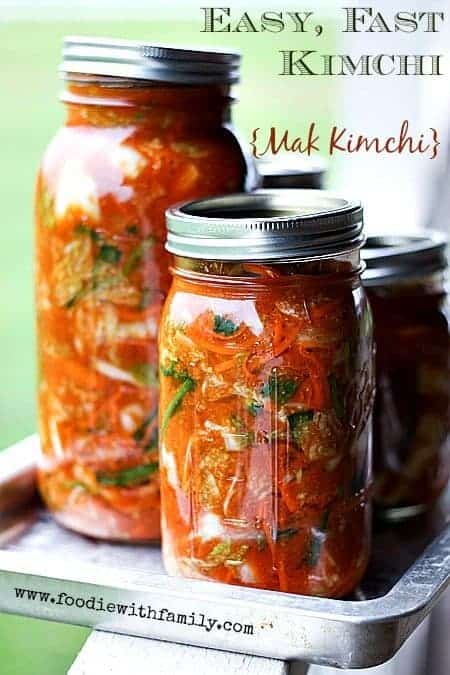
Love this Easy, Fast Mak Kimchi recipe? Check out our other fabulous Korean Food Recipes!
If you’ve been with me for a while, you’re well aware of my undying love for kimchi. Yes, it is stinky and bubbly and more than a little wild, but WOWZA the taste and the texture are so worth it.
If you’re new to the Foodie with Family family and you aren’t familiar with kimchi, I can give you a super condensed description; it’s essentially spicy, aromatic Korean sauerkraut. Today, I’m bringing you a fool-proof Easy Fast Kimchi recipe {Mak Kimchi}.
What is Kimchi?
Kimchi comes in almost as many forms as there are vegetables because nearly any vegetable can be fermented. They range from super mild smell to mega funky and mellow to melt-your-face-off spicy and there is one for every possible point in between.
The kimchi recipe that I’m sharing today is my family’s favourite version. It’s chock full of fabulous pro-biotics (as most kimchi is) and the longer it ages (translation: ferments) the stronger it becomes in both flavour AND pro-biotic content.
It’s like yogurt on steroids, people. That’s how good it is for you!
Is Kimchi Good For You?
Health Magazine named kimchi one of it’s Top 5 World’s Healthiest Foods. It is is low in calories and fat and high in dietary fiber and wicked high in Vitamins A, B, and C.
Many (if not most) Koreans eat a little kimchi with each meal or at least once a day. Kimchi is credited with helping most Koreans avoid obesity by virtue of its ability to satisfy even while being low calorie and low fat.
Seoul National University conducted a study and claimed that chickens infected with the H5N1 virus, also called avian flu, recovered after eating food containing the same cultured bacteria found in kimchi. That’s good enough for me!
How to Make Kimchi
Let’s get cracking and make some kimchi, shall we? The variety we’re making today is an Easy, Fast Kimchi recipe or Mak Kimchi…
In other words, it’s already cut up and ready to shovel into your mouth. Unlike what is usually just called ‘kimchi’ which is whole heads of napa cabbage smeared with the kimchi paste and allowed to ferment all wrapped up.
This version is FAR easier to make and far faster to be ready. Bonus, it is way easier to eat straight from the jar with a pair of chopsticks or a fork.
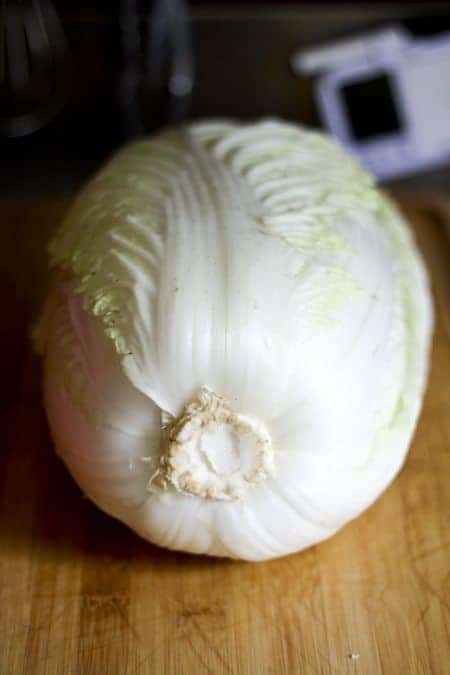
Do I need special tools to make kimchi?
In short, no. All you really need is a knife, a cutting board, and a big bowl. You will need a couple of ingredients that you may not have purchased before, but never fear, they’re not hard to find these days and I’ve included links to them below.
To begin with, you’ll need a big old head or two of Napa cabbage. I had two heads like the one above weighing in at about 3 pounds each.
It yielded, when all was said and done, about 3 quarts of kimchi, so that was perfect for me. You can cut that back if you think you can’t consume that amount of our Easy, Fast Kimchi recipe or Mak kimchi.
But I find all sorts of places to tuck it in, so it’s not an issue here and it’s only my husband, myself, and two of our boys who eat it. We love our kimchi.
Kimchi Recipe
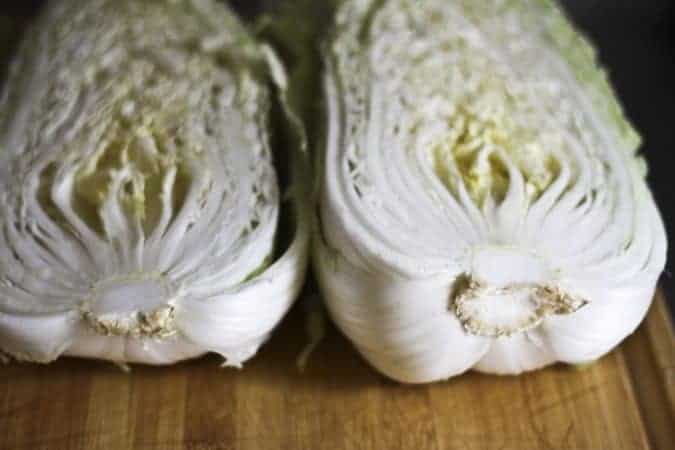
Lob your cabbages in half lengthwise. Use a paring knife to remove the gnarly core from them before cutting in half lengthwise again, leaving you with quarters.
Cut across the quarters to make bite-sized squares of cabbage. I usually shoot for 2-inch squares.
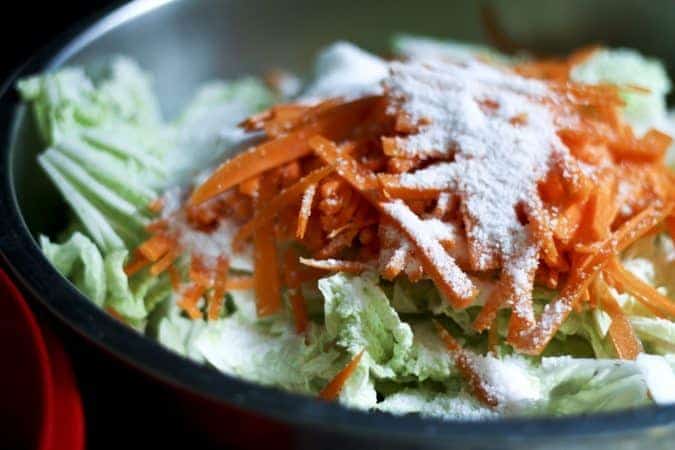
Add the cabbage to a monstrously huge bowl (or bowls), top with the julienned carrots, and sprinkle salt over the whole works. Toss the veggies and massage the mixture until the cabbage just starts to wilt.
Pour in enough cold water to over all the cabbage and carrots by a bit. It doesn’t have to be swimming in water, just covered.
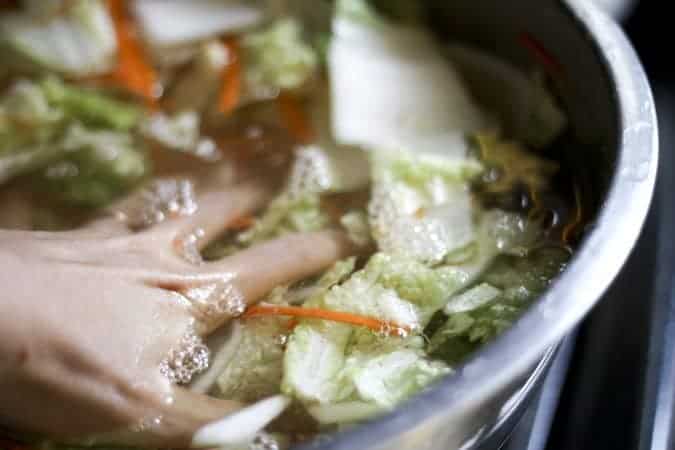
Stir it up with your hands and let it rest at room temp for a couple of hours.
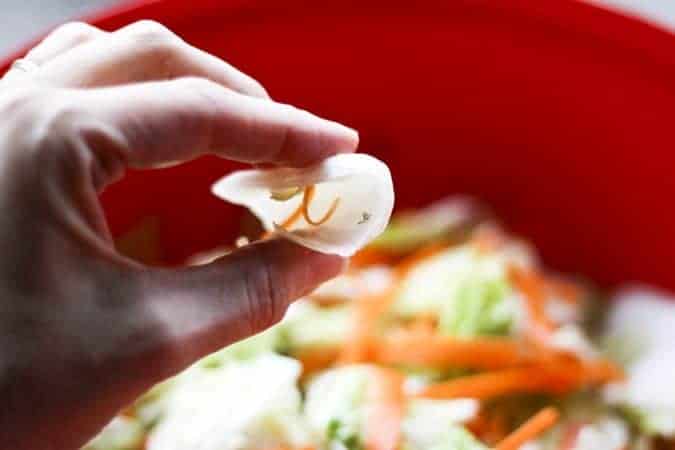
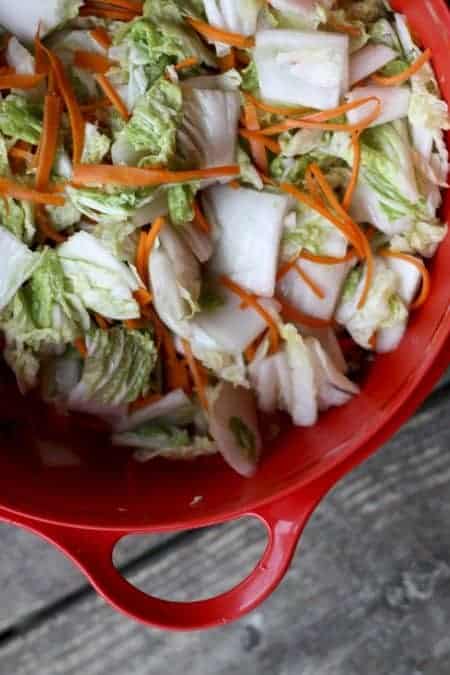
After a couple of hours, when the sturdier pieces of cabbage have become flexible, pour the whole lot into a strainer and let the brine water drain away.
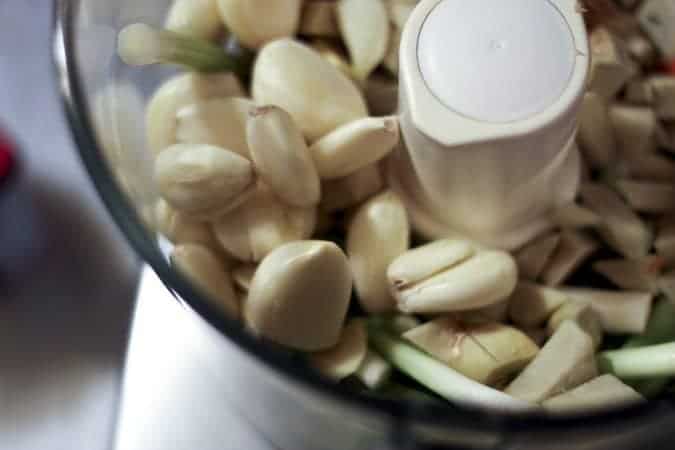
Now you’re going to whizz up the good stuff. Garlic, ginger, the white parts of scallions, Korean Red Pepper Powder*, fish sauce, unsweetened pear or apple juice, miso paste, and whatnot go into the food processor or blender.
Obliterate and smash it all into a lovely, red, fabulous smelling paste. It’s worth noting that you shouldn’t just up and increase the garlic because it can make kimchi linger more on your breath than you’d like it to do.
It also tastes out of balance if you add a lot more. Be aware.
And by the same token, you shouldn’t increase the ginger willy-nilly because that can make the final product a little more bitter than you’d like it to be. Start with the mixture and proportions I’m giving you and then play with it in subsequent batches.
*It’s important to note that you cannot use American or Mexican Chili Powder in place of the Korean pepper powder here. They’re COMPLETELY different animals. It may end up tasty, but I haven’t tested it so I cannot speak to it.
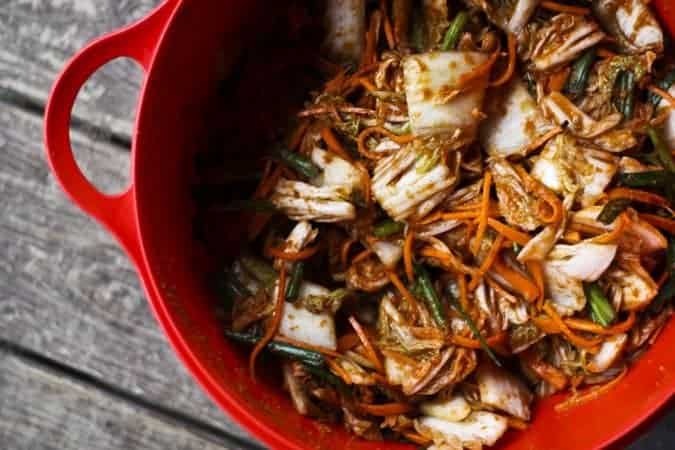
Now you’ll CRAM this stuff into jars or food-safe plastic containers. When I say cram it, I mean shove it in there as firmly as you can without putting your fist through the bottom of the jar.
I do prefer glass canning jars, if you’re wondering, because they don’t retain odors like plastic does, and, well, this stuff is odiferous! You can use a dedicated plastic kimchi bucket if you’d prefer, though.
Gently place a lid and ring on the jar, but don’t screw it tightly into place because BOOM. It’ll pop. This is active stuff, mes amies!
Place the jar on a rimmed pan or baking dish. The rim is pretty crucial here, because as the kimchi ferments at room temperature (and more slowly but still actively in the refrigerator) it will bubble up and may release a little juice over the edge of the jars.
In other words, you could have a kimchi river a-flowin’ on your counter top unless you take precautions. It’s easiest to use the pan and not worry about your Easy, Fast Kimchi recipe or Mak Kimchi bubbling over onto your counters.
It’s going to spend a couple of days at room temperature getting bubbly and fragrant. Every day, you’ll insert a clean chopstick or butter knife into the jar to help release air bubbles and top the jar off with extra brine if needed to keep everything submerged.
When it’s almost carbonated looking (usually between 24-72 hours after packing the jars), it’s ready to refrigerate. I highly recommend refrigerating it on the tray you used to contain the Grand Kimchi River while it fermented.
There aren’t a lot of things quite as unnecessary as removing everything from a fridge and mopping kimchi juices off of it. Take my word for it.
How long can I keep homemade kimchi?
It’s ready to eat at that point! Of course, it gets stronger and more kimchi-y the longer it sits. I love cooking with the older stuff and eating the newer stuff ‘raw’.
One of my all-time best-loved ways to eat older kimchi is in pancake form. Not like Aunt Jemima pancakes or flapjacks, but savoury, crispy-edged, kimchi-studded, pan-fried, snack cakes that convert even die-hard kimchi skeptics.
It’s the only way my eldest likes kimchi, but OH how he loves it this way. And the smell of kimchi pancakes while they cook is irresistible.
Bonus: This stuff lasts just about forever when you make sure the veggies are submerged in the brine. It’s hard to go wrong.
What can I make with my kimchi recipe? How do I use kimchi?
-Kimchi Fried Rice AND another version of Kimchi Fried Rice (the second one has a fried egg on top. SWOON!)
-Korean Army Stew- Budae Jjigae
-Kimchijeon (Savoury Kimchi Pancake)
Kimchi Ingredients
Kimchi
Cut the napa cabbage in half longways, then in half again longways. Cut the core out of the four quarters.
Cut the cabbage into squares (about 2-3 inches square), pop it in a bowl with the carrots. Sprinkle with the 1/2 cup kosher salt, massage so everything is coated in salt and starting to soften and wilt. Fill with cold, chlorine free water to cover it well and let it soak for at least 1 1/2 hours.
Pour the cabbage and carrots and liquid into a strainer. Let the brine drain away.
Lob off the white bits of the green onions and put them in a food processor with the garlic cloves, ginger, miso paste, and korean pepper powder. Zap it on high ’til it’s smooth-ish. Add in the fish sauce and a couple of slops of pear juice and zap it more until it’s about pancake batter consistency… maybe a bit thinner.
Put the brined cabbabe/carrots in a big, anti-reactive (glass, enamel, or stainless steel) bowl. Rough chop the green parts of the onions and add those to the cabbage/carrots. Pour the chili paste combo over the cabbage and wear gloves to massage it all over the cabbage/carrots green onions so everything is completely covered.
Pack super tight in canning jars. CRAM it in there.
Add a two-piece lid, but just set the ring in place to hold the lid down without screwing it in place. Place it on a rimmed baking dish to catch any spill-over.
Let it sit at room temperature for up to 72 hours, until it is bubbly and fragrant. Once every day, insert a clean chopstick or butter-knife to release air bubbles. If needed, pour in some additional brine to keep all the vegetables submerged.
Store on a rimmed sheet in the refrigerator for up to six months, being sure that the vegetables are submerged the whole time. The older it gets, the stronger it will become.
Notes
If you need extra brine to keep your vegetables submerged, please combine 1 quart of cool water with 4 teaspoons of kosher salt in a quart jar with a tight fitting lid and shake until the salt is dissolved. Use it to top off the vegetables as needed.
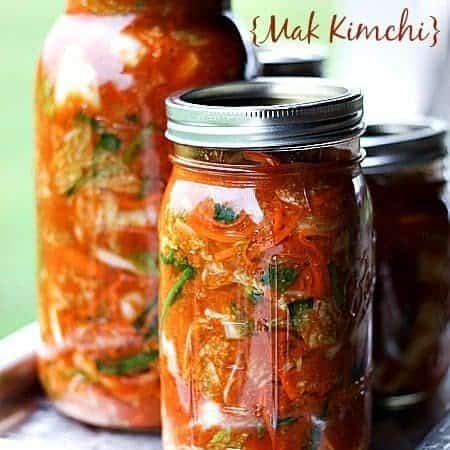
Easy, Fast Kimchi Recipe {Mak Kimchi}
Rate RecipeIngredients
- 3-8 pounds napa cabbage
- 2 bunches green onions trimmed of the root bits
- 2-3 large carrots peeled, thinly julienned
- 1/2 cup kosher salt
- 1/2 cup korean chili powder
- 15-20 cloves garlic overdoing garlic makes this stay on your breath more than usual., peeled
- 4-6 inches ginger peeled, rough chopped
- 1 tablespoon fish sauce
- unsweetened pear juice or unsweetened apple juice
- 4 tablespoons white miso paste
Instructions
- Cut the napa cabbage in half longways, then in half again longways. Cut the core out of the four quarters. Cut the cabbage into squares (about 2-3 inches square), pop it in a bowl with the carrots. Sprinkle with the 1/2 cup kosher salt, massage so everything is coated in salt and starting to soften and wilt. Fill with cold, chlorine free water to cover it well and let it soak for at least 1 1/2 hours.
- Pour the cabbage and carrots and liquid into a strainer. Let the brine drain away.
- Lob off the white bits of the green onions and put them in a food processor with the garlic cloves, ginger, miso paste, and korean pepper powder. Zap it on high ’til it’s smooth-ish. Add in the fish sauce and a couple of slops of pear juice and zap it more until it’s about pancake batter consistency… maybe a bit thinner.
- Put the brined cabbabe/carrots in a big, anti-reactive (glass, enamel, or stainless steel) bowl. Rough chop the green parts of the onions and add those to the cabbage/carrots. Pour the chili paste combo over the cabbage and wear gloves to massage it all over the cabbage/carrots green onions so everything is completely covered.
- Pack super tight in canning jars. CRAM it in there. Add a two-piece lid, but just set the ring in place to hold the lid down without screwing it in place. Place it on a rimmed baking dish to catch any spill-over. Let it sit at room temperature for up to 72 hours, until it is bubbly and fragrant. Once every day, insert a clean chopstick or butterknife to release air bubbles. If needed, pour in some additional brine to keep all the vegetables submerged.
- Store on a rimmed sheet in the refrigerator for up to six months, being sure that the vegetables are submerged the whole time. The older it gets, the stronger it will become.
Notes
Nutrition
Nutritional information is an estimate and provided to you as a courtesy. You should calculate the nutritional information with the actual ingredients used in your recipe using your preferred nutrition calculator.
did you make this recipe?
Make sure to tag @foodiewithfam on Instagram and #hashtag it #foodiewithfamily so I can check it out!
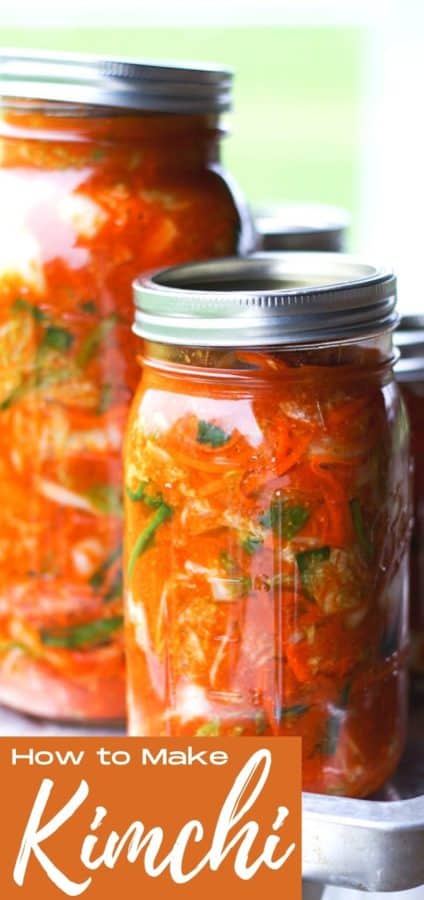
This post was originally published on December 2, 2013 and was updated December 28, 2016, June 2018, and September 2021.
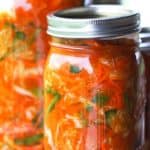



Reader's Thoughts...
Diana says
Interesting to see that your receipt use apple juice. What does apple juice do, since it’s unsweetened .. dont think it helps with the fermenting, maybe add to the flavour? I may have miss it , but how much apple juice should I use? 200 ml? Enough to cover the cabbage?
Rebecca says
Hi Diana- It adds fructose which the pear would also do… you do not need to add a specific amount. You’re just adding enough to loosen up the paste in the food processor until you hit about pancake batter thickness!
Diana says
Thanks ! I just tried making kimchi using your recipe, and I totally love it ! 🙂 I think the apple juice does make it more flavorful ! 🙂
Rebecca says
Thanks so much for taking the time to rate the recipe and let me know you love it, Diana! I truly appreciate it and I’m glad you love it.
Sarah says
Once I put mine in the fridge the water got all soaked up. Should I put more water over the top??
Rebecca says
Hi Sarah- You should add a little brine to make sure it is topped off… just 4 teaspoons of kosher salt to 1 quart of cool water, stirred until it is dissolved. 🙂
Bnkie says
I made this recipe today and canned 6 pints. The pot I used for the final mix smelled so good, I didn’t want to wash it! If this stuff tastes remotely as good as it smells, it is going to be an absolute culinary treat! Being a foodie who loves delicious flavors. I believe this recipe to be ‘out of the park’. Can’t wit for 3 days to pass soon can dig in! Ok, I confess, I did taste it and even unfermented, it was amazing! It’s going to be along 3 days! Thanks for sharing!
Rebecca says
Hey Bnkie! I’m so glad you love it and took the time to rate the recipe and let me know!
Nancy says
This is the second time I’m making kimchi and wanted to thank you for the recipe. I got a beautiful water sealed fermentation crock for Mother’s Day and I’m obsessed with kimchi.
Thanks!
Rebecca says
I’m so glad you love it, Nancy! Thanks for taking the time to let me know!
Helen Bower says
Sounds good. Can I use Gochujang instead of Korean Chilli powder?
Rebecca says
Hi Helen- I’m sorry to say I’m not much help here because I haven’t tried that. I would mention that gochujang isn’t pure chile powder, but has additional ingredients and is fermented. That’s not to say it won’t work, I just don’t know how much you’d use and what the results would be. If you decide to play around with it, please let me know how it turns out for you!
Ed says
1/ what is “white miso paste” and where there is none such, what can be substituted?
2/ is what “korean chili powder” actually “cayene powder” (which is _not_ north-american ‘chili powder’ at all.
Rebecca says
Hi Ed- Let’s see if I can help you with your questions. First, miso paste is a fermented soy paste that both helps kick start fermentation and adds some umami to the party. If you don’t want to purchase it (at Asian markets and better stocked grocery stores) or order it (Amazon and other online food retailers), you can omit it. Second, Korean chile powder is not cayenne pepper. It is coarsely ground, sun-dried chile pepper flakes with about 10,000 Scoville units. You can read about it here. It is also available very inexpensively at Asian markets, at some better stocked grocery stores, and online (Amazon and others). I have not personally used other peppers in place of it (it’s also called gochugaru), but I understand some people have.
Mentari says
Thank you for the recipe! Love!!
Today is first day of fermentation and when I tasted it, it’s less spicy, can I add more gochugaru when it’s still fermenting?
Also the water/brine is like triple now, is that normal? Thank you..
Rebecca says
Thanks for taking the time to rate the recipe and let me know you love it, Mentari! xoxo I don’t see any problem with adding more gochugaru, but I’d do it sparingly after the first day. And it is totally normal for the liquid to increase like that… I am so glad you are happy with your results. 🙂
Ben says
Looks great! I made pickled daikon carrot relish for Vietnamese food so this looks perfect to make as my next pickled Asian side dish. I hear you want distilled or spring water to allow the natural fermentation process to work correctly.
Rebecca says
I have well water, so that works beautifully. If you’re using town/treated water, you may want to go with spring water.
Irene Yew says
How much pear juice or apple juice to add in? I don’t think I see the portion in your recipe.
Rebecca says
Hi Irene- I don’t give a hard and fast amount. You need to use visual queues to know how much you’re adding. You are basically loosening up the paste a bit with it. It probably won’t amount to any more than 1/4 or 1/2 cup, but that’s dependent on your veg that you’re whizzing up in the food processor.
Onyinye says
Hello, I discovered kimchi when I watched the Korean drama called “Boys before flowers”. It looked spicy and delicious. I want to learn how to make this and your steps seem simple but I am in Nigeria and there are things I can’t get here in my country. For example pear juice, miso paste, Korean chilly power (Can I use any chilly pepper in place of this?).
I hope to hear from you soon.
Rebecca says
Hi Onyinye! You can use unsweetened apple juice, omit the miso paste, and if you can’t find Korean chile powder, you might try any of these substitutes: Cayenne pepper flakes. One of the most easily found ingredients is Cayenne pepper whether it is flakes or its ground form. …
Chipotle powder. Chipotle peppers are made with dried and smoked red jalapeno peppers. …
Aleppo pepper powder. …
Smoked Paprika. …
Chile Pasilla. …
Gochujang.
Please let me know if you have any other questions!
Beth Taylor says
What would you recommend to make this more spicy hot?
Rebecca says
Hi Beth- You could add more Korean chile flakes or you could add some thinly sliced wickedly hot peppers like habaneros or bird chiles or something of that sort. 🙂
Adam says
Hi Rebecca, can any unused brine be frozen for use in another batch? Great recipe! Thanks!
Rebecca says
Hi Adam- Thanks so much for taking the time to rate the recipe. Just to clarify, are we talking about the brine that is salt stirred into water that we use to top off the kimchi? If so, I’d be inclined to just make a smaller batch and send what you don’t use down the drain. If you mean the kimchi brine, I think that sounds like a lovely idea to deepen the flavour.
Erin says
This recipe is so good! I had never made kimchi prior to using this recipe, and I am now on my third batch. I’ve put beets and cauliflower in it as well.
I use 1/4 cup salt instead of 1/2 cup though, and it is to my preferred taste. Also, I use whatever spices I have on hand (red pepper flakes, dried chiles) and it turns out so good! Thank you for posting this.
Rebecca says
You’re very welcome, Erin! Thanks for taking the time to rate the recipe and let me know it was flexible for you!
Mindy says
It’s Mindy again. I made my “shelter in place” version. I was actually able to use kosher salt thanks to amazon prim. I did have to use tap water. I was a little nervous about the ginger because of the measurement. I have never used it. I used a pear because I couldn’t find the juice. The paste turned out a little thick. I think I used more napa cabage than the recipe called for because it made four quarts. When I saw the kimchi not covered with liquid I just pressed it back down. It was at the top of the jar so there was no room to add brine. It turned out perfect !! I will have to make more in a month. It doesn’t take me long to go through it. I eat it with everything and alone too. I will definitely try your kimchi pancake recipe as well. Thank you and be safe and well during this time and always.
Rebecca says
Thanks so much for checking back in, Mindy! I’m awfully glad it turned out great for you and I appreciate that you took the time to come back and rate the recipe and let us know!
Jessica says
Hi, can I purée in a fresh Apple instead of Apple juice?
Rebecca says
You betcha, Jessica! That’ll work great!
Sarah says
Hi – I’m excited to try this recipe! I have some plastic gallon containers that previously held ice cream. It looks like the plastic won’t be a problem, but I can’t get a sense of how much kimchi your recipe makes. How many quart jars do you usually fill up?
Rebecca says
Hi Sarah- It really depends on how much Napa cabbage you start with… there’s quite a range in the recipe. 🙂 If I start with the lower end of the range, I end up with close to 3 quarts, usually.
Leticia Jones says
Hello! I’ve been buying so much kimchi from the store I’ve finally decided to give your recipe a try! I was reading through and it says to drain the brine water. Then later it says to add brine water to top it off or refill to keep the kimchi longer. Should I store the brine water in a jar or justmade regular ol’ salt water as needed? I’m sorry that part really confused me.
Rebecca says
Hi Leticia! You’ll want regular ol’ salt water to top it off with rather than the stuff you drained off in the first couple of steps. 🙂 Thanks for asking me to clarify!
Sterls says
I have Gochujang on hand, how do I use this instead of Korean Chili Powder? I am having trouble finding the equivalent measurement. PLEASE HELP!!! Thx!
Rebecca says
Hi Sterls- I’m terribly sorry to say that I’m not sure what the equivalent amount is. Gochujang is slightly different in that it is a fermented chile paste, so you may have to do some experimenting.
Mindy says
I can’t wait to make this because I am kimchi crazy. One little jar of kimchi costs five dollars if you can find it. In these times with covid 19 ingredients are hard to find especially bottled water. I ordered the fresh ingredients and hope those will all be available so I can make this recipe. I only have regular salt so I hope that will be ok. I will let you know how my “shelter in place” version turns out. Also hoping tap water will be ok since that’s all I can get. P.s. that stomachs cancer comment is ridiculous. Thank you for all your efforts and I hope you get enough money for all your boys to go to college.
Rebecca says
You’re awfully sweet, Mindy. <3 Thank you so much for your kindness. I think your shelter in place version should be amazing and it will be fun for you to be able to compare what it tastes like to the "original" version when things get back to being normalish. 🙂 Happy Quarantine-Cooking!
Scott says
Thank you for your devotion and dedication to your blog, the work you put into this is superb.
I have never made kimchi before, but when I do I’ll be using this. I can taste it already!
Respectfully yours,
Scott
Rebecca says
Thanks so much, Scott! I hope you get the chance to make it soon!
Drina says
If your jars are too dry and you need to top your jars off with brine, What do you use to top them off?
Rebecca says
In a separate container, mix together 4 teaspoons kosher salt with 4 cups of water until the salt is dissolved. Use this as needed to top off the jars. 🙂
Rebecca says
That should have been 4 teaspoons in 4 cups! 🙂